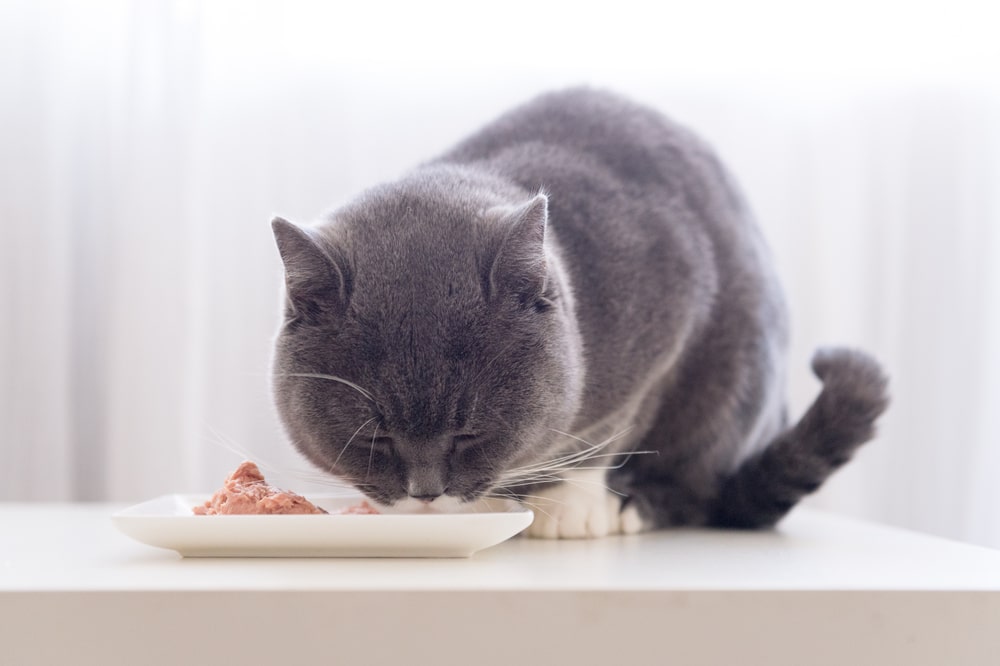Review Summary
We give WholeHearted Cat food a rating of 4 out of 5 stars.
WholeHearted pet foods was created by Petco in 2016, beginning with a line of affordable dog food, and cat foods were introduced a year later. Petco is a pet food and pet accessory company founded in the 1960s with a focus, in the company’s words, on “trailblazing new standards in pet care, delivering comprehensive wellness solutions through our products and services, and creating communities that deepen the pet-pet parent bond.”
WholeHearted pet food is made by a third-party manufacturer on behalf of Petco, although this manufacturer is not disclosed by the company. The company uses only the finest quality ingredients to create a variety of grain-free foods for cats at all stages of life, including dry food, canned food, and treats.
While quality food at an affordable price this sounds great, we thought that we’d take a deeper dive into the brand and find out whether its claims are worthy of your hard-earned dollars.
At a Glance: The Best WholeHearted Cat Food Recipes
| Image | Product | Details | |
|---|---|---|---|
Our Favorite

|
WholeHearted Chicken & Pumpkin Recipe Flaked in Broth |
|
CHECK PRICE |

|
WholeHearted Beef & Pea Recipe for All Life Stages |
|
CHECK PRICE |

|
WholeHearted Chicken Recipe for All Life Stages |
|
CHECK PRICE |

|
WholeHearted All Life Stages Chicken & Tuna |
|
CHECK PRICE |

|
WholeHearted All Life Stages Chicken & Beef Recipe Morsels in Gravy |
|
CHECK PRICE |
WholeHearted Cat Food Reviewed
WholeHearted offers a fairly diverse array of cat foods, including canned food, dry food, treats, kitten food, and foods that target specific health issues like obesity and digestive issues. All the company’s foods are grain-free (as they should be) and are free from artificial colors and animal by-products.
Dry foods always require a binder ingredient, which is usually sourced from grains like corn, wheat, or soy. WholeHearted cat foods are all grain-free and make use of potato, pea, and legume starch as binders instead.
Overall, WholeHearted makes great quality cat food at an affordable price and offers around 40 different cat food products.
Who Makes WholeHearted Cat Food and Where Is It Produced?
WholeHearted pet food is manufactured by Petco, a company focused on healthier pets that have been in business for more than 50 years. Petco has almost 1,500 locations across the United States, Mexico, and Puerto Rico, with a thriving online-based pet-wellness business.
WholeHearted cat food is made by an undisclosed third-party manufacturer on behalf of Petco. While we do know that the food is manufactured in the United States, the company is not overly transparent about the source of its ingredients, only some of which are sourced locally.

Which Types of Cats Is WholeHearted Best Suited For?
WholeHearted offers a range of cat foods to suit almost all ages, breeds, and sizes of cats, including specialized recipes for cats with digestive issues, recipes for urinary support, and limited-ingredient recipes for cats that have allergies. The company makes food that is suitable for all ages, as well as specialized recipes for kittens and seniors.
Overall, the variety of foods that WholeHearted offers is enough to suit almost any cat, from kittens to seniors and cats with health issues, all at an affordable price. This is a convenient point, as switching brands of cat food is both time-consuming and expensive. With WholeHearted, you can get almost any type of food you need under one brand umbrella.
If it’s kibble, wet, or a combination of both that your cat enjoys, choosing the right cat bowl to serve it in goes far beyond presentation. Your cat's comfort is at the forefront with the Hepper NomNom Cat Bowl! The unique design benefits cats in many ways - dual stainless steel bowls are shallow and wide to aid with whisker fatigue and slight elevation for proper posture. The wide catch tray ensures that all food (and water!) stays exactly where you’d expect it to be - inside of the bowl! Click here to learn more. At Catster, we’ve admired Hepper for many years and decided to take a controlling ownership interest so that we could benefit from the outstanding designs of this cool cat company!
What Are the Primary Ingredients (Good and Bad) in WholeHearted Cat Food?
Overall, the ingredients used in WholeHearted Cat foods seem to be of high quality, with mostly animal-based protein sources. Most of the formulas use chicken, fish, or beef as the first listed ingredient and contain no animal by-products.
All of WholeHearted’s foods are free from artificial colors and dyes, which are unnecessary and potentially harmful ingredients for your cat. These dyes are often used to make the food look more appealing to the consumer to help the product sell better, and chances are high that if the company needs to dye their food, the included ingredients can’t be that great to begin with.
A handful of pet food manufacturers use anonymous meat ingredients in their pet food. These are defined as animal-based ingredients that come from an anonymous source and are highly controversial, as they can come from almost any source with no means of tracing. These types of meats are usually inexpensive and fairly low in nutrition. We’ve found that WholeHearted uses anonymous fish meats in three different products.
While all of WholeHearted’s cat food recipes are grain-free, they do include other filler ingredients, including powdered cellulose and pea protein. Powdered cellulose is derived from particles of wood pulp and plant fibers and is nutritionally empty apart from its fiber content. Produced from removing the starchy parts of peas, pea protein is lower in nutritional value than its meat counterparts.

A high number of WholeHearted’s recipes contain menadione sodium bisulfite complex, a synthetic version of vitamin K that has been linked to some health issues in dogs and cats. While vitamin K is an essential nutrient in animals, the synthetic version may have possible toxic reactions in liver cells and red blood cells.
A Quick Look at WholeHearted Cat Food
- Made in the United States
- No history of recalls
- Animal-based protein sources
- All recipes are grain-free
- Free from animal by-products
- Free from artificial dyes and colors
- Contains non-grain fillers, including peas and powdered cellulose
- Contains anonymous meat sources
- Some recipes contain menadione sodium bisulfite complex
Reviews of the 3 Best WholeHearted Cat Food Recipes
With no history of recalls and decent grain-free recipes that are packed with animal-sourced protein, here are three of our favorite cat foods from WholeHearted.
1. WholeHearted Grain Free Chicken & Pumpkin Recipe Flaked in Broth Wet Cat Food

This wet cat food formula contains chicken as the first listed ingredient for a protein-rich wet food that your cat will love. It also contains vitamin-rich pumpkin and essential omega-3 fatty acids that will make your cat’s coat shine and keep their skin healthy. It has a crude protein content of 8% minimum, which may seem low, but wet cat food has high moisture content. This will provide your cat with adequate hydration while eating, and the food comes in convenient 80-gram pouches, a perfect on-the-go meal.
This food contains guar gum, which some experts link to possible medical issues in cats, as well as tuna oil, which some cats may be allergic to.
Calorie Breakdown:
- Real chicken as the first ingredient
- Contains vitamin-rich pumpkin
- Contains essential omega-3 fatty acids
- High moisture content
- Comes in convenient on-the-go pouches
- Contain guar gum
- Contains tuna oil, a potential allergen
2. WholeHearted Grain Free Beef and Pea Recipe Dry Cat Food for All Life Stages

This dry cat food from WholeHearted is suitable for all life stages and contains beef and beef meal as the first two ingredients, which are both quality sources of protein. The food also contains added probiotics to aid in immune health and omega-3 essential fatty acids from flaxseeds for healthy skin and coat. It has a 36% crude protein content and is free from artificial colors.
This food is fairly high in carbohydrates, which make up around 40% total. It is also lower in protein than some other similar products and contains salmon oil, which some cats are allergic to.
Calorie Breakdown:
- Suitable for all life stages
- Beef and beef meal are the first two listed ingredients
- Added probiotics
- Contains omega-3 fatty acids
- Free from artificial dyes and colors
- High in carbohydrates
- Comparatively low in protein
- Contains salmon oil
3. WholeHearted Grain Free Limited Ingredient Chicken Recipe Dry Cat Food for All Life Stages

This dry kibble from WholeHearted contains real chicken as the first ingredient and primary source of protein. It also contains chicken meal for protein as part of its limited, five key-ingredient formula. The food is fortified with natural probiotics to aid in your cat’s immune health and is formulated without potato or soy. It has a total crude protein content of 40% and is free from grains and meat by-products.
This dry food is high in carbohydrates, however, around 31% total, and contains a potential allergen in the form of fish oil.
Calorie Breakdown:
- Chicken is the primary protein source
- Limited to five essential ingredients
- Contains natural probiotics
- Free from potato and soy
- High carbohydrate content
- Contains fish oil, a potential allergen
What Other Users Are Saying
WholeHearted cat food is a relatively new brand on the scene and has no current or past recalls. Due to its reasonable prices and high-quality ingredients that are free from grains, this food has piqued the interest of many cat owners. Here’s what a few other trusted sources are saying about WholeHearted:
- Allaboutcats: “If you’re on a tight budget but don’t want to sacrifice good nutrition, WholeHearted might be a good option to consider. Their wet recipes stand out as some of the only low-priced foods that combine decent ingredient quality with low carbohydrate content.”
- Felineliving: “Overall, WholeHearted is a highly recommended brand to try. It is a great grain-free option for those who are looking for more affordable pet food. While their standard cat food products are not all protein, the plant-based ingredients are sources of fiber, antioxidants, and vitamins. These are nutrients that felines can also benefit from.”
- Amazon: We always check reviews on Amazon from other cat lovers before we purchase a new brand of cat food. You can see these reviews here.
Conclusion
Overall, WholeHearted has delivered a brand of cat food that is affordable but still manages to tick most of the boxes in terms of good nutrition. While there are several questionable ingredients that we feel could have been left out, the dry food and wet food have great sources of animal-based protein.
The food is available in both dry and wet forms, as well as in specialized recipes for kittens, seniors, and cats with health issues, which we think is a great addition. Add in the fact that this food is yet to receive any recalls, and you are getting great quality food from a trustworthy manufacturer.
WholeHearted cat food is an affordable yet high-quality food that will give your cat all the nutrition they need to thrive.
Looking for additional cat food reviews? Check out:
- Nature’s Variety Instinct Cat Food Review: Recalls, Pros & Cons
- Acana vs. Orijen Cat Food: Our In-Depth Comparison
- Wellness vs. Blue Buffalo Cat Food: Our In-Depth Comparison
Contents
- Review Summary
- At a Glance: The Best WholeHearted Cat Food Recipes
- WholeHearted Cat Food Reviewed
- Who Makes WholeHearted Cat Food and Where Is It Produced?
- Which Types of Cats Is WholeHearted Best Suited For?
- What Are the Primary Ingredients (Good and Bad) in WholeHearted Cat Food?
- A Quick Look at WholeHearted Cat Food
- Reviews of the 3 Best WholeHearted Cat Food Recipes
- 1. WholeHearted Grain Free Chicken & Pumpkin Recipe Flaked in Broth Wet Cat Food
- Calorie Breakdown:
- 2. WholeHearted Grain Free Beef and Pea Recipe Dry Cat Food for All Life Stages
- Calorie Breakdown:
- 3. WholeHearted Grain Free Limited Ingredient Chicken Recipe Dry Cat Food for All Life Stages
- Calorie Breakdown:
- What Other Users Are Saying
- Conclusion


















